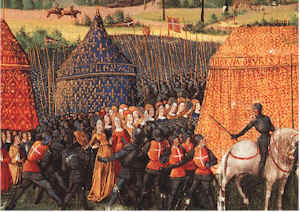
The winter was a desperate time, and many of the
Crusaders died from a combination of starvation and exposure. As morale dropped,
people began deserting - most notably William the Carpenter (the Lord of Melun)
and Peter the Hermit. Both these men were later rounded up by Tancred and
brought back to the camp.
| By January, the Provençal knights had lost so many horses that they began refusing to escort the foraging parties. In response, the leaders tried several measures to lift spirits. Compensation was offered to knights who lost their horses in battle. There were religious events and, in February, Adhémar called for the expulsion of the women from the army camp. Tatikios, whose position among the western crusaders had become increasingly untenable, left the siege to return to Byzantine-controlled territory. |
 The women are banished from the crusader camp. From a 15th Century manuscript. |
It was around this time that a second relief force,
under the command of Ridwan of Aleppo, approached Antioch. The crusaders had few
mounted knights left to meet this new threat, but those that they had, maybe
only 700 in total, they amalgamated into a single force under the command of
Bohemond. Under cover of darkness, this force slipped out and laid an ambush for
the approaching army.
Bohemond divided his army into six squadrons and hid
them behind a low hill. As Ridwan's army approached, the first five squadrons
charged down upon his vanguard. They panicked and fell back upon the main force
as it tried to deploy. Ridwan managed to rally his troops but, just as it looked
as though the crusaders would be overcome, Bohemond launched his reserve upon
Ridwan's main army and put them to flight.
Spring brings hope for the crusaders
By the spring, supply routes had been improved. The Armenians had captured Harem, a large fort which had been a thorn in the crusader's side since the start of the siege. Because of this and other actions, there was now a steady flow of food from Edessa and from Cyprus along roads and through ports controlled by the crusaders. In March, another tower, Mahommeries, was constructed, this time by Raymond's forces, Mahommeries blocked the Bridge Gate, giving protection to supply columns travelling up from St Symeon and further tightening the noose around Antioch.
Bohemond makes a deal
| Meanwhile, it was Bohemond who held the key to the cities demise. He had been in secret negotiations with a man called Firuz, who commanded one of the towers on the south-eastern part of the wall. Firuz was an Armenian, recently converted to Islam but sympathetic to the Christians. He would let the crusaders into his tower. Bohemond wanted to strike a deal with the other crusade leaders. He would engineer the capture of the city, but his price was that Antioch would be given to him. |
Antioch betrayed Yaghi Siyan, emir of Antioch, displayed unprecedented bravery, presence of mind, wisdom and activity; consequently most of the Franks died there. Yaghi Siyan did not fail to provide for the needs of the families of the Christian men whom he had forced to leave the town, and he prevented those - who otherwise would have been tempted - from doing them wrong. Finally, despite these precautions, the Franks came to an agreement with the commander of one of Antioch's towers, a breastplate-maker called Firuz: they promised him silver and considerable wealth if he would betray the city to them. Ibn al-athir, The Sum of World History. |
The other leaders demurred, some wanted the city to be split equitably, some felt that they should honour their oaths to Alexius and give the city to the Byzantines. None of them wanted to simply hand such a powerful prize over to Bohemond.
Kerbogha approaches
In the end, it was the approach of a third relief army that forced them into a
decision. The relief army, commanded by Kerbogha, the Turkish ruler of Mosul,
was far more powerful than any they had had to face before. As well as his own
troops, he had gathered allies from all around, including Arlan-Tasch of Sinjar,
Qaradja of Harran, Balduk of Samosata, Janah-ad-Dauluh of Homs, and the
still-powerful army of Duqaq. The news of his approach terrified the crusaders,
and many deserted. The most notable of these was Stephen of Blois, who had no
confidence in Bohemond's furtive plans. He boarded a ship on 2 June 1098 and
sailed off to warn Alexius, who was approaching with his own army, that all was
lost.
|
The crusader leaders knew that would be massacred if they were in the open when Kerbogha arrived, so they quickly agreed to Bohemond's plan. That same evening, 2-3 June, the crusaders stormed into the city through Firuz's tower. In the darkness, thousands of the city's residents, Christian and Muslim, were slaughtered. |
|
|
Yaghi Siyan fled, accompanied by thirty bodyguards, only to be later captured and killed by Armenian Christians. The victory celebrations were short lived. Kerbogha's army arrived the next day and now it was the crusaders turn to be besieged. |
Yaghi Siyan escapes Yaghi Siyan woke up and asked what all the noise was. His men told him that the trumpet calls were coming from the citadel, which must therefore have been occupied by the enemy. Now, the noise was not coming from the citadel but from the tower; nevertheless, Yaghi Siyan was seized with fear and, giving orders for one of the town gates to be opened, he fled, accompanied only by thirty attendants. Ibn al-athir, The Sum of World History. |
Copyright © 1999 Dr Tom J Rees. All rights reserved